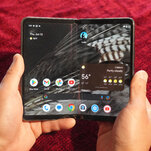
Google Pixel Fold Review: Foldable Phones Are Improving
When I recently turned on Google’s new Pixel Fold smartphone and unfolded it as if it were a book, it transformed into a miniature tablet, similar to an iPad Mini or an Amazon Fire. Then something unexpected happened.
For the next few hours, I found it difficult to put the device down, as if I were sucked into a great novel. The phone’s performance was smooth and fast, and the bigger screen made reading emails, watching videos and reading comic books more delightful than on a normal phone screen.
I was surprised because I have been wary of foldable phones. The earliest models released by Samsung, Motorola and Huawei about four years ago had glaring flaws. They were thick and heavy, had durability issues and lacked software to take advantage of their novel hardware. But I immediately knew the Pixel Fold — Google’s first foldable phone — was different.
When I folded the device back up, a second 5.8-inch outer screen illuminated, converting it into a regular smartphone that could be used with one hand. Importantly, it was not too chunky — it’s about half an inch thick folded up, which is slightly bigger than my iPhone — so it was comfortable to carry in my pockets.
The Pixel Fold, which was unveiled last month and arrives on Wednesday, is proof that when cutting-edge technology emerges, it is wiser to wait before sinking your hard-earned dollars into it. In just four years, Google has managed to erase most of the problems with foldable phones, transforming a gimmicky concept into a product with compelling reasons to exist.
What Google didn’t manage to do was make foldable phone technology cheaper. The Pixel Fold costs $1,800, about $400 more than similar phones released a few years ago. Google said the device’s cost partly stemmed from the engineering challenge of cramming high-quality components, including a camera on a par with other Pixel phones, into a device this thin. (When unfolded, the Pixel Fold is thinner than a typical smartphone.)
That’s a bummer. Most people won’t spend this much on a phone when there are many great options that are cheaper. But I can recommend it for its target audience: people with lots of disposable income who rely heavily on their devices.
Still, the progress with foldable technology is good news. A few years ago, handsets from companies like Apple and Samsung seemed to have peaked. Their flagship phones were already incredibly zippy, their screens were big and bright, and their cameras took stunning photos. The smartphone industry, as a whole, became a pile of nearly indistinguishable black rectangles.
What was left to do? In 2019, Samsung was among the first to release a foldable phone, but it poisoned the well by rushing the gadget to market. The screens on early review samples of its Galaxy Fold failed, forcing the South Korean manufacturer to postpone the product. Samsung and others have since released a few more foldable phones, but none were compelling to me.
Google’s entry into the market is significant. Mirroring Apple’s tight control of the iPhone’s design, Google designed both the hardware (including the computing processor) and software that power the Pixel Fold. That means the device’s software was tailored to work with it, and it has long battery life and very fast performance.
Beyond the bigger screen, Google has come up with clever reasons for how and why you might use a foldable phone.
For one, the Pixel Fold is a great video player to use everywhere because of the way it folds at an angle like a laptop.
When I cooked in the kitchen, I played a YouTube video with a recipe and folded the device at a 90-degree angle. The upper half of the screen showed the video, and the lower half showed the description listing the ingredients. In some ways, this was even better than a tablet, which you would have to prop up with a stand on the countertop to view at the proper angle.
What else might you do with a foldable? With the device unfolded, I ran two apps side by side, which was useful for reading a webpage while typing an email.
Google also demonstrated how its translation app could take advantage of the two screens. Consider a situation in which you, an English speaker, are trying to communicate with someone who speaks Chinese. Holding the phone unfolded, you can speak English into the microphone and have the phone’s outer screen show text translated into Chinese to the other person. When the Chinese speaker responds, you can read the translated text on the inner screen.
This feature will not be released until the fall, so I didn’t get to test it. But it’s an intriguing use case.
In the end, the device is expensive because it is packed with advanced technology with no major trade-offs. In my tests, its camera produced crisp and vibrant images on a par with photos taken with Apple’s latest iPhone and the Pixel 7 Pro, Google’s $900 smartphone, which has an excellent camera.
Though the Pixel Fold’s high price will make it inaccessible to most people, it was an exciting glimpse into the next step for smartphones. Over the last five years, as phone screens got bigger, we have voted with our wallets and shown that we prefer larger screens, so long as they come on devices easy to carry everywhere. The Pixel Fold delivers that.
I suspect that in a few years, foldable phones will probably fall in price to replace current phones with the “pro” moniker and will make up the new high end of the market. When that happens, I can see myself and many others making the switch to a foldable — and a future where the tablet becomes less relevant.

